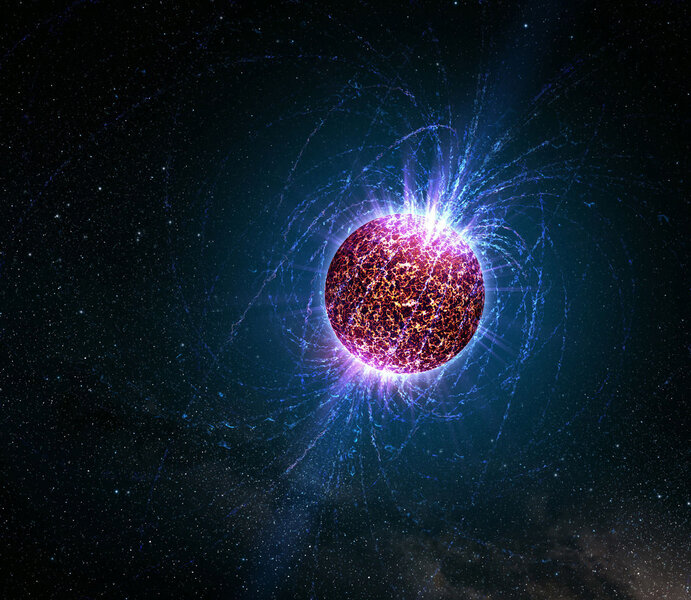Create a free profile to get unlimited access to exclusive videos, sweepstakes, and more!
Axions, dark matter, and neutron stars: How to find the Universe's most mysterious matter

One of the most outstanding puzzles in all of astrophysics right now is simply stated: What the frak is dark matter*?
We know it exists and we know it's pretty much everywhere in the Universe, we know the kinds of things it does and the kinds of things it doesn't do… but, embarrassingly, we don't know what it actually is.
We have some good ideas, so scientists have been looking to see if any of these ideas pan out. In a recent paper, astronomers report looking for one particular flavor of dark matter — low-mass axions — and they didn't see it. That's unfortunate, since these weird subatomic particles are a pretty good guess for what makes up dark matter. However, it doesn't rule out axions entirely as dark matter, and in fact could spur on further tests.
So. The existence of dark matter was first realistically proposed by astronomer Vera Rubin to explain unusual characteristics in the rotations of galaxies, as well as how galaxies behaved when they were in clusters. It was as if all these objects had way more gravity than expected given the amount of mass we see in them. If there was some dark matter, something that didn't give off light so we can't see it, surrounding galaxies, it outweighs "normal" matter (like protons and electrons, the stuff that make up us) by a factor of five or six.
Lots of ideas were floated for what it could be, but almost everything on that list would have other effects we'd be able to see one way or another. Over the decades all that's left on the list now are pretty exotic candidates like teeny tiny black holes (unlikely, but an interesting idea) or some kind of subatomic particle we haven't discovered yet.
As it happens, there are a host of theoretical issues particle physicists have with the way the quantum universe behaves, and have proposed a particle that could account for them, fixing the problems. These particles would have very low mass, wouldn't interact with normal matter, wouldn't emit light, and there would be a whole lot of them out there in the Universe at large. They're the perfect candidates for dark matter.
They named these proposed particles axions, after — and I cannot adequately state how much I love this — a dish detergent.
But how do you observe something that doesn't emit light? Well, it turns out under specific circumstances they can. In the presence of very strong magnetic fields, axions should convert into energy (remember E=mc2? That says that matter and energy are two sides of the same coin, and can be converted into each other). Given the very low mass we think axions are, they would convert into light in the radio part of the spectrum.
As it happens, neutron stars — the collapsed cores of massive stars after they explode as supernovae — have incredibly strong magnetic fields, sometimes trillions of times the Earth's, even higher in rare kinds. And we can point radio telescopes at them, too. If axions decay into radio waves, maybe we can see them.
So that's what the astronomers tried to do. Using the immense 100-meter Green Bank and Effelsberg Telescopes, they looked at two isolated neutron stars, as well as toward the core of the Milky Way galaxy, where there should be thousands of neutrons stars seen collectively. Just to be careful they also took a look at the nearby Andromeda Galaxy, since for a given field of view they'd see even more neutron stars that way, and the globular cluster M54, a nearby collection of about a hundred thousand stars, which should have a lot of neutron stars in its core as well.
What they were looking for was emission of radio light at very specific frequencies corresponding to the energy axions would have for their mass. The mass of the axion isn't well known, but could lie in a small range. The astronomers therefore looked for any sharp emission in that energy range... and didn't see any.
That's disappointing. But it doesn't rule out axions as being dark matter. For one thing, they couldn't check the entire energy range the axions might emit at. They could only look at about half the expected range, and so perhaps axions are slightly higher mass and don't give off the light the radio telescopes were looking for. Further observations are planned to cover that.
It could be that there aren't enough axions around neutrons stars to make enough light, making them too faint to detect, or that other forces are at work making it hard to spot. Or it may mean that axions don't emit radio light, or, most pessimistically, are not the dark matter we're looking for, and it may instead be made of far more massive particles called WIMPs (Weakly Interacting Massive Particles).
With the advances made recently in particle detectors and telescopes, I don't think it'll be too much longer before we have a far better understand of what dark matter actually is.
So while the new results are a little disappointing, I'm still excited. And it also fills me with wonder.
The Universe is unfathomably large, hundreds of sextillions of kilometers across (and that's just the part we can see; it extends much further than that, possibly infinitely further), but it's made up of particles where one a quadrillionth of a meter wide is considered large.
To understand the cosmos we need to examine the extraordinarily tiny and the soul-crushingly huge, grasping them both at the same time. And we humans, stuck in the middle of these two vastly different size scales, have the ability to do just that. We're rather amazing that way.
*The choice of adjectives in professional journal papers may vary.





























